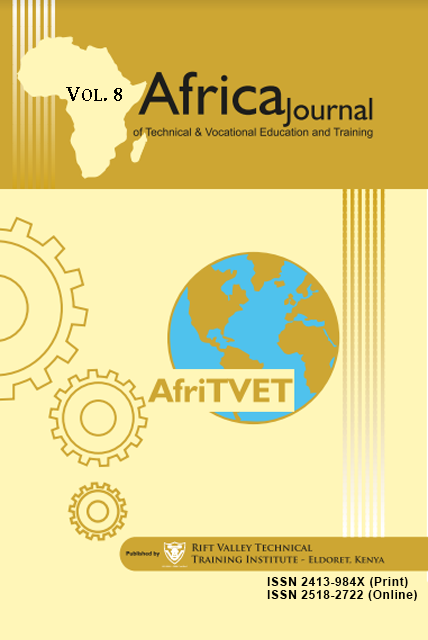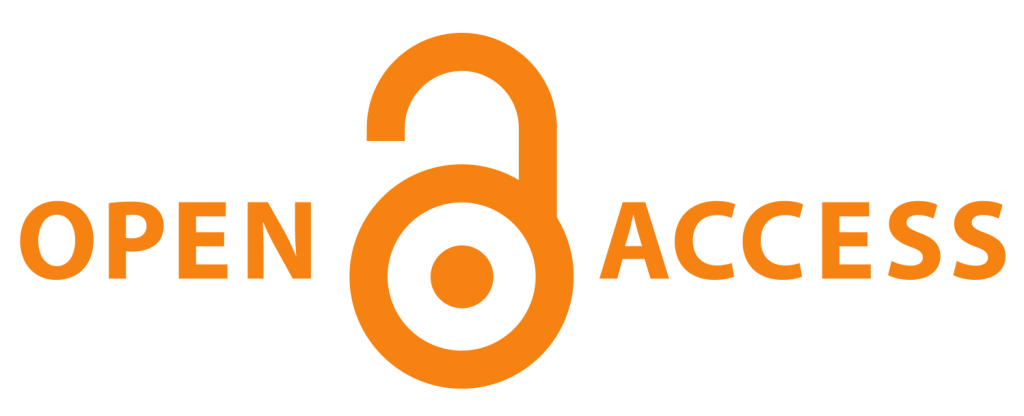Routine Risk Management Strategies in TVET Institutions’ Operations. A Case of Coast Institute of Technology
Abstract
Educational institutions continue to operate in a volatile environment characterized by a myriad of challenges. Furthermore, the institutions are confronted with a future that is marked with uncertainty. The concealed risks are threatening to derail the attainment of the anticipated vision and objectives. Therefore, this demands for a change of strategy in order for the institutions to maintain their focus. Given the limited information on the risk position of educational institutions, this study sought to find out how TVET institutions manage risk in their routine operations. The study used a mixed methods approach to explore the risk management strategies adopted in the implementation of programmes. Data was collected through one-on-one interview with the principal, deputy principal, dean of students, head of department and analysis of relevant documents. This was complimented with a survey administered to the lecturers at the institution. Findings from this study reveal that there was lack of an elaborate risk management framework that could be used to address potential and emerging risks in the institution. Moreover, there was minimal indication of the knowledge of risk management though there were activities that seemed to focus on the identification of risks. The findings from the study were that 72% of the lecturers rated the institution’s approach to management of major risks as poor. The unfamiliarity with risk management strategies made the managing of risks to become a reactive and inconsistent activity. The study recommends that risk management be incorporated in the strategic processes of educational institutions. For this to materialize there is need for continuous professional development of the administrators and the lecturers to upgrade their skills on risk management. The Ministry of Education should also develop a policy framework to support the institutionalization of risk management in the operations of the institutions.
Article Views and Downloands Counter
References
AGBUCUE. (2009). The State of Risk Management at Colleges and Universities Today. Washington, DC: Association of Governing Boards of Universities and Colleges and United Educator.
AIRMIC. (2010). A structured approach to enterprise risk management (ERM) and the requirements of ISO 31000. The Association of Insurance and Risk Managers. Retrieved from www.airmic.com
Alarm. (2010). A structured approach to enterprise risk management. The Public Risk Management Association. Retrieved from www.Alarm-uk.org
Anderson, T. J. (2000). Strategic planning, Autonomous actions and corporate performance. Long Range Planning, 33, 184–200.
Aven, T., & Kristensen, V. (2005). Perspectives on risk: Review and discussion of the basis for establishing a unifying and holistic framework. Reliability Engineering and Safety System, 90(1), 1–14.
Bassey, C. O., & Dokubo, C. Q. (2011). Defence Policy of Nigeria: Capability and Context. Bloomington: AuthorHouse.
Biesta, G. (2012). Mixed methods. In J. Arthur, M. Waring, R. Coe., & L. V. Hedges (Eds.), Research Methods and Methodologies in Education. Los Angeles: SAGE.
Cassidy, D., Goldstein, S. L., Johnson, L., Mattie, J. A., & Morley, J. E. J. (2001). Developing a Strategy to Manage Enterprise wide Risk in Higher Education. Washington, DC: National Association of and University Business Officers and Pricewaterhouse Coopers.
Creswell, J. W. (2007). Qualitative Inquiry & Research Resign: Choosing among Five Approaches (2nd ed.). Thousand Oaks: Sage Publications. Creswell, J. W. (2009). Research Design: Qualitative, Quantitative, and Mixed Methods Approaches (3rd ed.). Thousand Oaks, Calif: Sage Publications.
Denscombe, M. (2010). The Good Research Guide for Small-Scale Social Research Projects. McGraw-Hill International.
Frase, L. E., English, F. W., & Poston, W. K. (2000). The Curriculum Management Audit: Improving School Quality. Oxford: R&L Education.
Gay, L. R. (2006). Educational Research: Competencies for Analysis and Applications (8th ed.). Upper Saddle River, N.J: Pearson Merrill Prentice Hall.
Glatthorn, A. A., & Jailall, J. M. (2009). The Principal as Curriculum Leader: Shaping What Is Taught and Tested. London: Corwin Press.
Helsloot, I., & Jong, W. (2006). Risk management in higher education and research in the Netherlands. Journal of Contingencies and Crisis Management, 14(3), 142–159.
Henn, M. (2009). A Critical Introduction to Social Research (2nd ed.). Los Angeles: SAGE.
IRM. (2010). A structured approach to risk management. The Institute of Risk Management. Retrieved from www.theirm.org
Kallman, J. W., & Maric, R. V. (2004). A Refined Risk Management Paradigm. Risk Management, 6(3),57–68.
Keough, S. M., & Shanahan, K. J. (2008). Scenario planning: Toward a more complete model for practice. Advances in Developing Human Resources, 10(2), 166–178. doi:10.1177/1523422307313311
Kusek, J. Z. (2004). Ten Steps to a Results-Based Monitoring and Evaluation System: A Handbook for Development Practitioners. Washington, DC: World Bank.
Ministry of Education. (2005). Strategic Plan 2006-2011. Nairobi: Government Printers.
NACUBO. (2007). Meeting the challenges of enterprise risk management in higher education. National Association of Colleges and Universities Business Officers and the Association of Governing Boards of Universities and Colleges.
Ong, M. K. (Ed.). (2006). Risk management: A modern perspective. Burlington, MA: Academic Press/Elsevier.
Razook, C. (2008). Risk management: So critical, yet so elusive. International Finance Corporation.
Sammut-Bonnici, T., & Galea, D. (2015). Swot analysis. In Professor Sir C. L Cooper (ed), Encyclopedia of Management. Chichester: John Wiley & Sons
Sarantakos, S. (2005). Social research (3rd ed.). New York: Palgrave Macmillan.
Smallman, C. (1999). Knowledge management as risk management: A need for open governance? Risk Management, 1(4), 7–20.
Susanto, A., & Meiryani. (2018). The importance of risk management in an organization. International Journal of Scientific & Technical Research, Vol 7, Issue 1, November 2018
Tucker, M. S., & Codding, J. B. (2003). The principal challenge: Leading and managing schools in an era of accountability. San Francisco, CA: John Wiley & Sons.
Turner, B. (1994). The future for risk research. Journal of Contingencies and Crisis Management, 2(3).
URMIA. (2007). ERM in higher education (White paper). Bloomington: URMIA.
Wieriks, R. H. Y. (2013). The Landscape of Sustainability Assurance. Rotterdam: Eburon Uitgeverij B.V.
Wilson, I. (1994). Strategic-Planning isn’t Dead: It Changed. Long Range Planning, 12–24.
Zapalac, P. (2006). Current Issues in Higher Education. NCURA Newsletter, XXXVII(5).
Copyright (c) 2023 Africa Journal of Technical and Vocational Education and Training

This work is licensed under a Creative Commons Attribution-NonCommercial-ShareAlike 4.0 International License.
Copyright Notice Copyright of published articles is held by AfriTVET. No limitation will be placed on the personal freedom of authors to copy or to use in subsequent work, material contained in their papers. Please contact the Publisher for clarification if you are unsure of the use of copyright material. Apart from fair dealing for the purposes of research and private study, or criticism and or review, this publication may only be reproduced, stored or transmitted, in any form or by any means, with the prior permission in writing of the Publishers.


